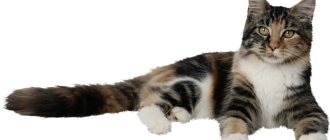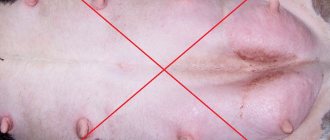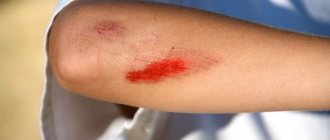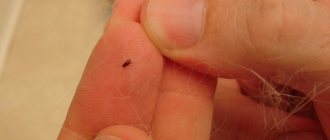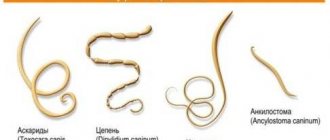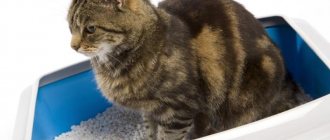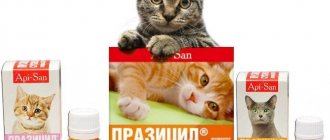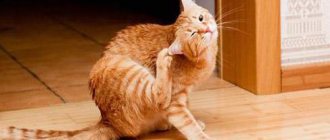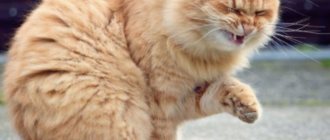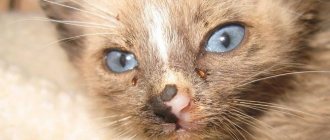For a happy cat's life, in addition to tasty and healthy food and warm petting from the owner, health is very important. Cats are also big fans of independent walks in secluded corners of the yard and apartment. Unfortunately, with this habit, your pet runs the risk of contracting either some unwanted disease or harboring parasites. And one of the most common problems with furry friends is fleas.
In this article we will tell you how to tell if your cat has fleas. We will also look at how to remove fleas from a cat using folk remedies. We will discuss all the nuances, pros and cons of folk remedies, and in which case which one would be better to use. We’ll also tell you separately how to remove fleas from a kitten.
Symptoms
By paying proper attention to your cat, you can see these insects firsthand. For example, during stroking. However, it may not be possible to “catch a flea in the act.” Be careful. If your cat has fleas, then her behavior will definitely attract your attention with its unusualness.
Cats that have fleas have:
- The cat scratches itself more often than usual. When fleas bite a cat and walk on its skin, it reacts naturally. Scratching too often is dangerous for your pet - he can scratch his skin until it bleeds. These fleas are so annoying.
- The cat bites itself. This is a reaction similar to the one described above to the presence of fleas.
- The cat became irritable and nervous. The cat feels constant tension. And this can easily be read in her behavior. She becomes more aggressive and cannot sit quietly in one place.
- The cat wakes up abruptly and jumps in its sleep. Fleas bite very painfully. When this happens during sleep, the cat wakes up very abruptly and may even immediately jump to the side. By the way, cat fleas bite people, and one day you too may get it.
Article on the topic: How to find out if a cat has fleas
If you observe at least one of the above symptoms in your pet, then you can confidently assume that your cat has problems. And our master's duty is to help our beloved tailed friend get rid of this trouble.
Special means
The advantage of medications is their proven effectiveness and safety. They act quickly, allowing the animal to be healed in the shortest possible time.
Flea collars
This is one of the most common means used for prevention. The collar has a medicinal scent that repels parasites. However, this device also has significant disadvantages:
- some of them are highly toxic, and therefore only collars with special markings can be used;
- the impact zone is limited to the head and ears, while the back of the cat remains unprotected;
- The product lasts about one month, after which the collar must be replaced;
- may cause the development of a local allergic reaction.
A collar is an effective method of fighting fleas.
Shampoos
Quite an effective remedy for fighting fleas. It is necessary to choose a shampoo from a trusted manufacturer, designed specifically for cats. It will be effective when the infection has not reached a critical stage, that is, when parting the fur does not reveal a huge number of insects.
After using shampoo, the animal must be thoroughly washed with running water so that no trace of shampoo remains. If there is special labeling, the product can also be used for small kittens.
Insecticidal drops
Drops are the most effective remedy, suitable for animals with different hair lengths. When choosing, you should give preference to trusted manufacturers and the least toxic substances. The only danger when using is the risk of licking the drug.
Flea drops will save your pet.
To avoid this, drops are applied to the animal’s withers, and if there are several cats, they are physically separated in space until the substance dries completely. It is also necessary to avoid getting the product on your hands.
Special sprays for fleas
Aerosols and sprays are very effective and equally toxic substances. They can only be used outdoors or in a well-ventilated area, as otherwise there is a high risk of poisoning. A couple of hours after applying the spray to the fur, the fleas die.
However, this may not work for cats with fluffy fur, as the product simply will not reach the animal's skin.
Note! During the period of treatment and drying, the pet must be wearing a high neck collar to prevent it from licking off the product. When treating the ears and neck, cover the cat's nose and eyes.
What to do and how to get rid of it?
Alternatively, you can go to the pharmacy and buy flea medications for cats to treat fleas on your cat. However, pharmaceutical drugs carry the risk of additional problems. Your cat may be allergic to the drug and may not tolerate the treatment process well, since flea treatments are toxic.
A good alternative is folk remedies for fleas in cats. Unlike the pharmacy version, folk remedies do not destroy insects, but, for the most part, “scare them away”, creating an environment unfavorable for their rampant activity.
First of all, when you decide to remove fleas, you must approach the issue comprehensively. It is not enough to simply rid your pet of these insects. There are probably a lot of flea eggs already laid around your house, so over time the problem may return.
You will need to pay due attention to caring for your cat, as well as carry out a general cleaning of the room and take special care of your cat’s favorite resting place: be it its pad, house or just its favorite chair.
Anti-flea shampoo recipe
Homemade shampoo is another effective folk remedy that helps remove fleas from a cat. The ingredients for the recipe can easily be found in any home:
- 1 tbsp. water (if desired, you can replace it with infusion of wormwood, tansy or geranium);
- 1/3 bar of baby soap;
- 1 chicken egg yolk;
- a few drops of essential oil.
The soap is grated on a coarse grater and filled with water or herbal infusion. Stirring constantly, cook in a water bath until thickened. Remove from heat, cool, add yolk and butter. Mix thoroughly.
The shampoo is used immediately after preparation. Apply the product to well-moistened animal hair, leave for 10 minutes, then rinse thoroughly. A week later the procedure is repeated.
Getting rid of fleas using folk remedies
We will look at several of the most popular flea remedies and decoctions for removing these parasites, which you can easily prepare at home.
Garlic
This is the most popular folk remedy. Fleas cannot tolerate the smell of garlic and do not stay long where it is present.
Garlic
To make a garlic flea remedy, you will need to squeeze out a few heads of garlic. Pour three glasses of water over the resulting garlic mixture and let it sit overnight. Then apply this water to your cat's fur. Only treat areas of the body that are difficult for your cat to reach. And that’s it: the fleas will run away on their own!
Attention! Garlic can be dangerous for your cat and can cause poisoning and intestinal and stomach problems if ingested. This is why you need to apply the garlic solution so that the cat cannot lick it off!
Salt
A very popular and affordable method for ridding a small kitten of fleas. Kittens are bathed in a basin with a saline solution of plain water and salt. The procedure lasts 15 minutes. After this, it is enough to dry the kitten well with a towel. However, the procedure should be done a couple of times a week.
Wormwood decoction
The smell of this plant is unbearable not only for fleas, but also for a number of other parasites. Let's look at how to get rid of fleas using wormwood decoction. To prepare, you will need either 40 grams of fresh wormwood leaves or 20 grams of dried ones. Boil this in two glasses of water. The resulting liquid is applied to the animal's fur.
Sagebrush
Wormwood is one of the most popular methods, because it not only drives away parasites very effectively, but is also absolutely safe for the animal.
Moreover, even kittens can be wiped with wormwood. The health of them and their mother will not be threatened. Kittens need to be treated with wormwood very carefully so that the smell is absorbed as strongly as possible into the fur and skin of the baby.
Comb
Yes, very simple. Comb! If you don’t have a special comb for your animal, then it’s time to get one at any pet store.
After this, take time and patience and carefully comb your cat's fur with a comb, thereby ridding it of fleas.
This method is suitable, first of all, as a temporary measure to make life a little easier for your animal. The fact is that you can comb out the fleas themselves, but it is unlikely that you will be able to rid the cat of nits, which cling very tightly and thoroughly to the fur. So in any case, after combing, you should still use one of the decoctions that we offer in this article.
Recipes for oils and solutions for fleas on cats
- Garlic mixture. If you add brewer's yeast to the garlic tincture, you will get a reliable remedy. The smell of this mixture will repel fleas and make you leave your cat alone.
- A decoction of tansy, eucalyptus and wormwood. These herbs are traditional in the fight against fleas. A decoction of these herbs is a reliable remedy that will not only drive away fleas, but also protect against other parasites such as bedbugs and mosquitoes. Pour boiling water over these herbs, and after an hour you need to strain the broth. After this, you need to rub the product into the animal’s skin every day. If your cat has already scratched its scratches, add mint oil to this decoction. This will make it easier to pinch the wounds.
- Geranium and lavender leaves. If you make a decoction of these leaves and treat your cat with it, the fleas will probably not tolerate it.
- Soap mixture. Add up to five drops of lavender, peppermint and ten drops of campfire oil to the liquid soap. Also add a little glycerin so that the resulting lotion is not so harsh and aggressive on the cat's skin. Apply this lotion to your skin periodically.
Bathing
Bathing your pet must be the first thing that comes to mind when you discover fleas. However, it is worth remembering that this is a rather stressful method for cats and kittens and you need to bathe them correctly.
To effectively get rid of fleas, you need to bathe as follows:
Mix camphor alcohol, 3% vinegar and cologne liquid (any). Apply the resulting product to the cat's body. Then put a plastic bag on the cat and hold the cat like that for 5 minutes. After this time, comb it thoroughly and dip it in water to buy. However, do not forget that the cat's head should be higher than its body.
spring-cleaning
It is worth remembering that it is not enough to get rid of fleas that have taken refuge on your animal’s body. You need to do a very thorough spring cleaning because fleas have probably already laid their eggs around the house.
Salt and soda solution
As a reliable cleaning product that will help get rid of fleas, a solution of salt and soda, 100 grams each, is suitable. It will not just repel fleas, but destroy them.
Causes and signs of flea infestation in a domestic cat
Fleas are ectoparasites that can live on the skin of almost all mammals on Earth. These are blood-sucking insects with an average size of 2–3 millimeters. They can easily change victims, settling in the fur of a dog, rabbit, rat or cat. Fleas not only cause serious physical harm to animals, they are carriers of a large number of diseases. A pet can become infected while walking from other animals or people. Often a person himself brings flea eggs or adult fleas on clothes and shoes into the apartment.
Places where fleas accumulate is the hair on the withers, behind the ears, on the stomach and in the folds of the paws.
A cat infected with fleas is accompanied by the following signs:
- the animal constantly itches and bites itself;
- appetite noticeably decreases;
- the cat sleeps restlessly, twitches or jumps while sleeping;
- Numerous wounds may appear on the skin, which quickly dry out and become covered with crusts;
- During examination, flea waste products, including eggs, mucus, excrement or adult insects, can be found in the fur and skin.
spring-cleaning
When talking about how to get rid of fleas from a cat using folk remedies, you need to immediately think about the room in which she lives. Parasites can be found not only on animals. They quite normally live for several days in wooden floor cracks, in bedding, and carpets. Therefore, in parallel with treating your pet, you need to disinfect the room. To do this, for a week you need to carefully vacuum carpets, upholstered furniture, rugs, that is, all possible places where fleas can remain and live long enough without an owner.
In addition, it is very useful to stock up on a spray bottle. With its help we will spray the rooms. Of all the available and natural remedies that nature generously shares with us, the most effective are solutions of essential oils of lavender, calamus and eucalyptus, as well as other aromatic plants. They do not have an unpleasant aroma, but are excellent at repelling fleas. Every day while performing preventive measures, spray them around the house. This can get on the floor, walls, carpets, and upholstered furniture. Place fresh wormwood around the area where the cat sleeps. All insects will try to immediately leave the room.
How does wormwood affect fleas?
Some plants help quickly drive fleas, mosquitoes, bedbugs and even small rodents out of the room.
These include wormwood. It does not poison parasites, but has a rather rich smell that repels uninvited “neighbors”. Fleas have poorly developed visual organs, and they look for food using their sense of smell. Smelling the bitter aroma of the grass, the insects leave the room in a hurry and do not return. Wormwood is considered a popular insect repellent due to:
- absolute safety for humans and pets. Wormwood grass does not have a negative effect on apartment owners, but on the contrary, creates an atmosphere of summer freshness in the room;
- no side effects. Processing can be safely carried out in the presence of household members;
- environmental safety: grass is allowed to be used in a house where there are small children. It is non-toxic and does not cause serious allergic reactions;
- This is an affordable product for any family's budget. The grass can be collected at the dacha, outside the city, or purchased at the market;
- decoctions, tinctures, brooms from the plant can be made independently and combined with other plants that have a similar effect.
The wormwood herb owes its repellent effect to the essential oils contained in large quantities in the stems and foliage. Preparations based on wormwood oil are often used in gardening to repel caterpillars and ants from young trees.
Does wormwood help against fleas? The plant, due to its specific smell, repels imagoes. As for the effect on humans, the smell is pleasant and is traditionally associated with the atmosphere of wildflowers. It is necessary to emphasize that only freshly cut or dried grass has a persistent odor. The effectiveness of wormwood against fleas in cats continues until the plant completely loses its aroma.
The grass is not taken as a poison. Even if you collect a small bouquet of this crop, nothing will happen. At the same time, the bloodsucker tries to leave the room, saturated with the smell of wormwood, in a matter of minutes. Such a striking repellent effect is due to the presence of volatile essential oils, which are contained in leaves, flowers and even stems. It is not surprising that wormwood essential oils are actively used in the 21st century.
Wormwood is actively used both to repel bloodsuckers in living spaces and to fight fleas in cats and dogs. The main requirement is to properly prepare the appropriate product. It can be prepared, and extremely simply.
We invite you to read: Instructions for use of Trauma for cats
Fleas on dogs
Dogs need to be walked regularly, so the risk of picking up parasites is high. This usually occurs upon contact with a source of spread (basement, entrance) or with a stray dog. Stray animals are carriers of all kinds of parasites and diseases, so do not allow your pet to come into contact with homeless relatives. The easiest way to protect your dog from fleas is to wear a special collar that repels pests with its composition, but this is only a preventive measure.
Preventive measures
To prevent the appearance of fleas, you must follow some hygiene rules:
- Periodically carry out pest control of the apartment.
- Carry out anti-flea treatment for your pet in strict accordance with the specified cycle of the drug used. Some products require application once every couple of months, others - once every six months.
- Bring your animal to the veterinarian for a preventive examination every year (more often if possible). The doctor will do a simple test to detect the appearance of fleas at an early stage, which will greatly facilitate the treatment process.
- Do not let the cat go out on its own. The danger here is posed not only by parasites, but also by stray animals.
Use preventative measures to avoid the proliferation of parasites on the cat’s body.
Removing fleas from a cat using folk remedies is a simple and quite effective solution. However, before using such substances, you must ensure that they are safe for the animal.
What to look for
First of all, this is the behavior of your pet. As soon as she gets fleas and starts biting her painfully, it will immediately become noticeable. The cat begins to itch and bite itself, and often jumps up while sleeping. If this behavior is present, then it’s time to proceed to inspection. When you part the fur, you will probably see scratched skin, and possibly small ulcers if the disease did not begin to progress today. On a light, not too thick coat, it is easy to find the insects themselves. They are elongated, shiny creatures that are difficult to catch and crush due to their chitinous coating.
Insects especially often gather along the ridge on the back. Where they not only feed, but also lay eggs. My second favorite place is the neck. By regularly inspecting these areas, you can be sure that not a single flea will pass by you.
Fleas on cats
Although usually a cat seems to be a peaceful domestic inhabitant who never leaves the apartment, some cats really like to escape into the entrance hall, where they can pick up parasites on their fluffy fur. The consequences of such a walk appear after a few hours; the pet begins to actively itch, but cannot eliminate the cause of the itching. Sometimes traces of scratching become red, six in these places fall out, and occasionally it comes to bleeding scratches. Try not to let your cat into the entrance or onto the street, and make trips to the veterinarian using a carrier.
Symptoms of fleas in an animal
At first, fleas may not show themselves, so it may seem that they appeared “out of nowhere.” If your pet begins to actively and incessantly scratch, this is the first alarming sign. Restlessness, licking and combing fur until bald spots are a clear sign of fleas. Examine the area where you scratched, see if there is any redness or scratches, and treat the affected areas. Spread the fur with your fingers in several places and you can determine the presence of fleas. How to save your pet from suffering?
Prevention
It is recommended to replace ordinary beds with mattresses with pine needles. They will repel fleas and prevent them from laying eggs. You can place fresh lemon and orange peels around the house. Or dry them, grind them into powder and add them to water before washing the floors. Cleaning can be done with bleach by pouring it into a bucket.
As a preventative measure, a collar is made by folding the cotton fabric several times. It is stitched, resulting in a tight belt. Velcro is attached to the ends. Then soak the collar in a solution of lavender, rosemary and alcohol oils, add a little catnip. Attach the belt to the pet's neck. The flea protection effect lasts for a month.
Due to low toxicity, the effectiveness of folk remedies is reduced compared to drugs. Therefore, it takes longer to kill fleas. After the destruction of parasites, it is necessary to repeat the treatment monthly for preventive purposes.
Why are fleas dangerous?
Fleas are not just pests crawling on the skin and fur, they can be dangerous and even lead to the death of the animal if not treated in time.
What is the danger:
- These parasites eat the skin and drink the cat's blood.
- Their saliva is toxic and causes irritation on damaged parts of the skin.
- Pests can cause anemia, especially in cats;
- If treatment is delayed for a long time, the pet’s fur will deteriorate and bald patches may appear;
- Various infections can penetrate through damaged areas of a cat's skin, including murine typhus;
- When parasites remain in a pet's fur for a long time, they cause itching and pain.
If the disease is detected in a timely manner and measures are taken immediately, then the risk of serious consequences is reduced significantly.
Essential oils
The odors of ethers are persistent and last a long time, so they are often used to repel parasites. The most effective against fleas are fir, eucalyptus, mint, geranium, citrus fruits, cloves, and tea tree. A concentrate, a solution of essential oil, is used. There are several processing methods:
- 5 drops of oil are rubbed in the withers area, where the pet cannot reach with its tongue;
- added to bathing shampoo;
- diluted with water, poured into a spray bottle, used as a spray;
- dissolve in the bath where the pet is bathed;
- soaked cotton pads are laid out in the house, near the sleeping area.
Concentrated essential oil can provoke an allergic reaction, so if irritation occurs, the product cannot be used in the future.

